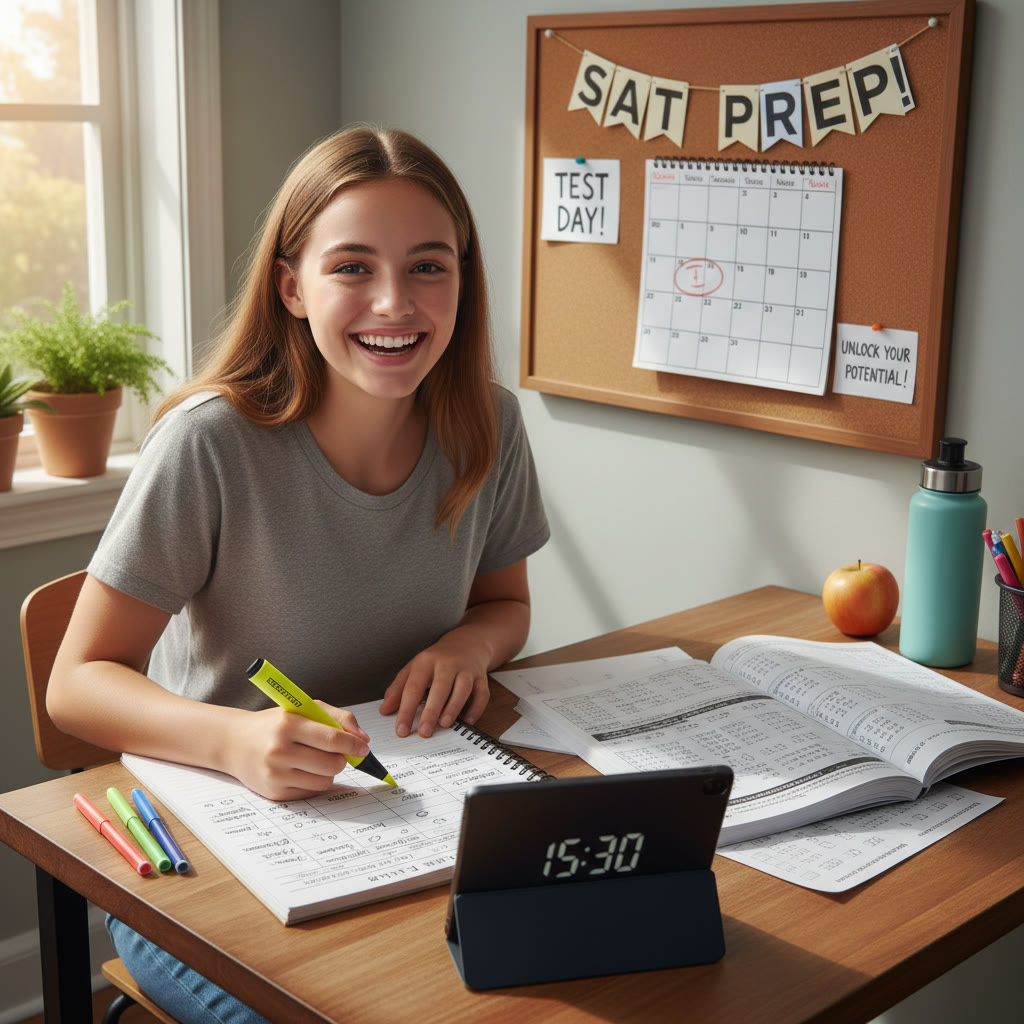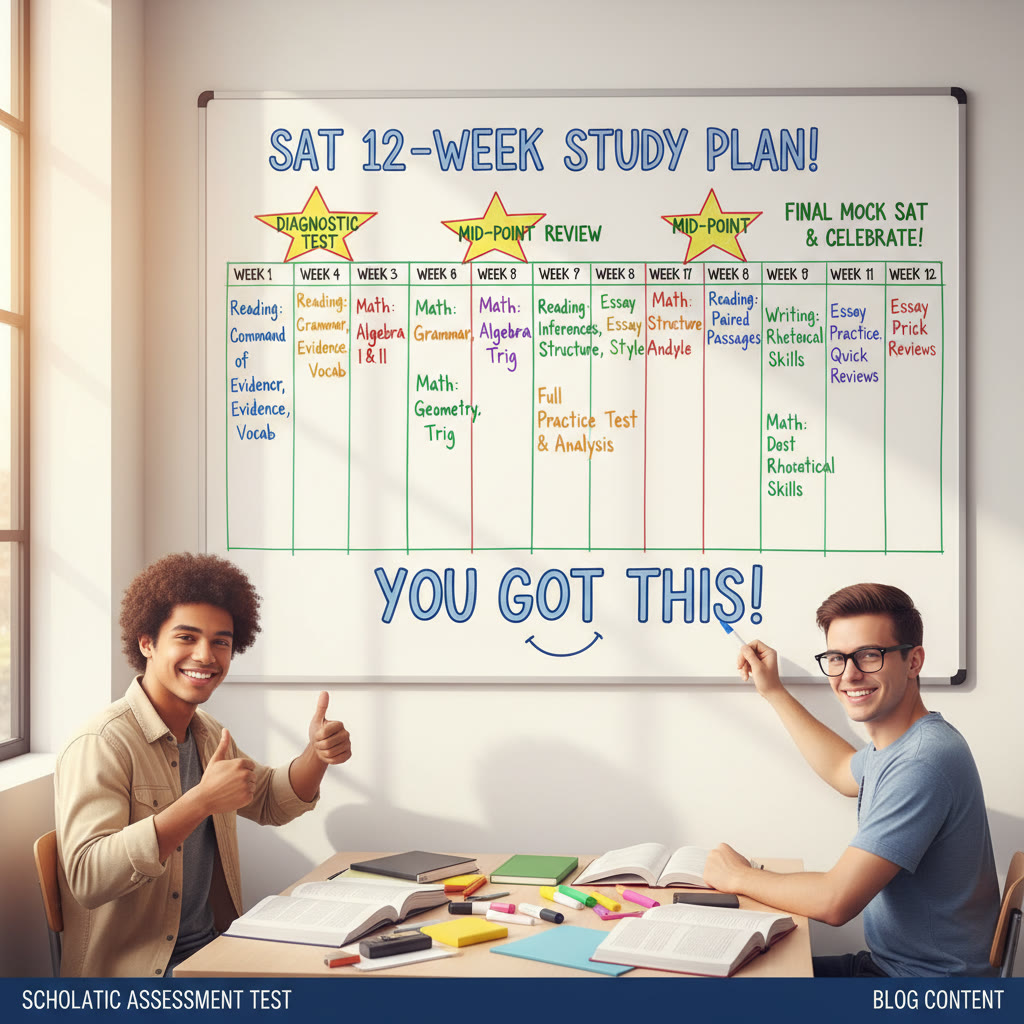Why a Personalized SAT Strategy Beats Generic Advice
Lots of SAT guides feel like a one-size-fits-all jacket: fine in the store, awkward in real life. Your strengths, weaknesses, schedule, and stress triggers are unique. So a study plan that fits you will be more effective, more motivating, and ultimately more efficient. Personalization is not about fancy tools or expensive promises — it’s about honest diagnosis, smart habits, and strategic practice.
Think of the SAT as a marathon with checkpoints. Two students can both run a marathon, but one trains with a track coach who times sprints, analyzes stride, and adjusts the plan each week. That student will probably run smarter and avoid injury. Your SAT prep should be similar: tailor training to your baseline and goals.
Step 1 — Know Where You Stand: Diagnostic Tests and Honest Reflection
The first step might be the least glamorous, but it’s the most important. Start with a full, timed practice test to get a realistic baseline. Take it under conditions that mimic test day: timed sections, minimal breaks, quiet space. Don’t peek at answer explanations until after you log your score and reactions.
After the test, answer two key questions:
- What score did I actually get? Break it down into Reading, Writing and Language, Math (No Calculator), and Math (Calculator).
- How did I feel during the test? Tired, rushed, confident, confused?
Use both objective results and subjective impressions. Maybe your Reading score is decent but you ran out of time on the last passage. That tells you time management, not comprehension, needs work.
How to document your diagnostic
- Record raw and scaled scores for each section.
- List the types of questions you missed (vocabulary-in-context, function of a paragraph, linear equations, trigonometry, etc.).
- Note timing problems: which passages or questions ate the most clock time?
- Rate your stress and focus on a scale of 1–5 for each section.
Step 2 — Set a Realistic Target and Timeline
Now translate your baseline into a target. If you scored 1100 and you want 1300, that’s a realistic 200-point increase but requires a structured plan — generally 8–12 weeks of focused work depending on how many hours per week you can commit. If you have six months, you can build a gentler, deeper plan with room for review.
When setting a timeline, be honest about daily life: schoolwork, extracurriculars, job, family obligations. A sustainable plan is better than an ambitious plan you abandon in week two.
Sample target-setting guide
- 0–50 point goal: focus on polishing, timed practice, and error reduction; 4–6 weeks.
- 50–150 point goal: targeted content review, strategy work, and regular full-length tests; 6–10 weeks.
- 150+ point goal: deep concept rebuilding, consistent practice, possibly personalized tutoring; 10–20 weeks.
Step 3 — Build the Plan: Weekly Structure and Daily Habits
A successful plan balances content review, strategy practice, and full-length tests. Here’s a framework you can adapt to a 12-week plan, shown with a typical weekly structure.
| Day | Main Focus | Typical Duration |
|---|---|---|
| Monday | Focused content review (e.g., algebra rules, grammar conventions) | 1–1.5 hours |
| Tuesday | Targeted practice problems + timed sections | 1–1.5 hours |
| Wednesday | Reading comprehension strategies and practice passages | 1 hour |
| Thursday | Math practice with review; error log update | 1–1.5 hours |
| Friday | Writing and Language practice; timing drills | 1 hour |
| Saturday | Full-length timed practice test (every 1–2 weeks) or mixed practice | 3–4 hours |
| Sunday | Review mistakes, rest, light reading | 30–60 minutes |
This schedule emphasizes consistency. Some weeks you’ll swap time to focus on a stubborn topic. The key is to keep a rhythm: practice, reflect, adjust.
Daily micro-habits that add up
- Warm up with 15 minutes of vocabulary or mental math each morning.
- Keep an error log: short explanation of each mistake and a note on how to avoid it next time.
- Use 20–30 minute focused blocks (Pomodoro-style) to maintain intensity without burnout.
Step 4 — Personalize by Weakness Type
Not all weak areas are the same. Your strategies should match the problem type.
Content gaps
If you’re missing content knowledge — certain algebra rules, geometry facts, or grammar rules — focus on concept rebuild. Use short lessons and immediately follow up with targeted practice problems. For example, if quadratic equations trip you, spend one session re-deriving the quadratic formula, another on factoring techniques, and then 3–5 practice problems applying each.
Strategy gaps
Sometimes the issue isn’t knowledge but approach: not knowing when to plug answers back, or how to triage hard questions under time pressure. Strategy lessons are drillable: practice timing, learn when to skip, and rehearse shortcut techniques (process of elimination, backsolving, plug numbers).
Timing and stamina
Running out of time is a common score sink. Build stamina with timed sets that replicate test pacing. Gradually increase the volume of timed practice to build endurance and reduce test-day fatigue.
Step 5 — Track Progress with Metrics and Reflection
Data is your friend, but it’s only useful if you reflect on it. Keep a simple tracker that logs:
- Practice test dates and scores (section and composite)
- Time spent studying each week
- Topics covered and common mistakes
- Mental and physical wellness notes (sleep, diet, stress)
Every two weeks, review the tracker to decide whether to keep the plan, increase focus on weak areas, or adjust pacing. Improvement isn’t strictly linear — plateaus are normal — but consistent review helps you spot trends.
Sample 12-Week Plan (Overview)
This sample gives structure to the framework above. Tailor the hours and sequencing to your baseline and goals.
| Weeks | Focus | Goal |
|---|---|---|
| 1–2 | Diagnostic review and core concept rebuilding | Establish baseline; close critical content gaps |
| 3–5 | Intensive practice on weak areas; timed sections | Develop strategies and timing |
| 6–8 | Full-length practice tests every 1–2 weeks; targeted review | Raise endurance and adapt to test rhythm |
| 9–11 | Polish strategies, reduce careless errors, simulated test conditions | Improve accuracy and consistency |
| 12 | Light review, test-day rehearsal, rest | Arrive calm and ready |
Step 6 — Learn From Mistakes: The Error Log
An error log is more valuable than more practice without reflection. For each mistake, capture:
- The problem and correct answer
- Why you missed it (content, silly mistake, time pressure, misread)
- A short note on how to prevent it next time
After two weeks, scan your log for patterns. If you consistently misread questions, add a ten-minute daily exercise of careful reading and annotation. If you make arithmetic errors, build a habit of double-checking or performing mental estimates to catch obvious miscalculations.
Step 7 — Practice Tests: Frequency, Review, and How to Use Them
Full-length practice tests are not just score checks; they are training simulations. Early on, take a full test every 2–3 weeks. As the test approaches, make them weekly. But the test itself is only half the value — the review is where learning happens.
After each practice test:
- Score it under timed conditions.
- Spend at least two hours reviewing mistakes.
- Update your error log.
- Adjust your next two weeks of study based on the results.
Step 8 — Mental Game and Test-Day Prep
Smart strategies on test day are simple but often overlooked. Treat test-day prep like a mini-simulation: sleep, nutrition, and timing matter.
Pre-test rituals
- Two nights before the test: avoid cramming; review high-yield notes for 30 minutes and rest well.
- Morning of: light breakfast with protein and slow carbs, hydrate, and do a 5–10 minute breathing or visualization routine to steady nerves.
- Arrive with time for check-in and to settle. Bring a watch, snacks for the break, and privacy for calming down between sections.
Remember: a calm, rested brain often outperforms a stressed, overworked one. That’s why consistent, manageable study beats frantic last-minute cramming.
How Personalized Tutoring Amplifies a Plan
Working with a tutor can accelerate progress if you pair tutoring with a clear plan. Personalized tutoring helps in three ways: focused accountability, immediate clarification of concepts, and tailored strategies. For example, if algebra is a recurring weakness, a tutor can quickly diagnose the exact misconception and provide a few high-impact drills that beat aimless problem sets.
Sparkl’s personalized tutoring is designed to integrate with plans like this. Tutors provide 1-on-1 guidance, tailored study plans, and expert feedback. They can help translate your diagnostic test into a week-by-week schedule, model test-taking strategies during practice sections, and use AI-driven insights to spot hidden patterns in your mistakes. The most effective use of tutoring is to combine sessions with independent practice and error-log review.
Practical Examples: Two Student Profiles
Here are two short case studies showing how personalization changes the plan.
Case A — Maya: Strong Reader, Weak in Algebra
Maya scored 680 in Evidence-Based Reading and Writing and 540 in Math. Her goal was 1300. Her plan focused on:
- Daily 30-minute targeted algebra practice, rebuilding core skills.
- Weekly timed math sections focusing on pacing and calculator strategies.
- Bi-weekly full-length tests to build confidence and measure gains.
After six weeks, with two tutoring sessions per week to review errors and teach shortcuts, Maya’s math score improved by 120 points. Her reading stayed steady while her math gains pushed her near her target.
Case B — Daniel: Solid Math, Slow on Reading
Daniel had 700 Math and 600 Reading. He lost points to slow pace and misread passages. His plan included:
- Daily 20–30 minute active reading exercises (annotating passages, summarizing paragraphs).
- Practice sections under stricter time limits to simulate pressure.
- One tutoring session weekly to practice passage triage and discuss timing strategies.
Within eight weeks Daniel’s reading speed and accuracy improved, and he developed a habit of sketching quick passage maps which helped him locate evidence faster.
Tools and Resources to Support Your Personalized Plan
A good plan uses a few reliable tools rather than a hundred apps. Here’s what works:
- A full-length official practice test bank for realistic practice.
- A simple spreadsheet or notebook for tracking scores and the error log.
- Flashcards for formulas or grammatical rules (physical or digital).
- Timed practice sets for pacing drills.
- Periodic check-ins with a tutor or mentor to stay accountable.
Quality matters more than quantity. A focused 45-minute session with clear outcomes and review beats three unfocused hours.
When to Consider Personalized Tutoring
If any of the following apply, tutoring is likely to help:
- You’ve hit a plateau despite consistent effort.
- You have a large score goal in a short time frame.
- You benefit from accountability and live feedback.
One-on-one tutoring, like Sparkl’s personalized tutoring, can provide tailored study plans, expert tutors, and AI-driven insights to identify patterns that are easy to miss on your own. Tutors can also simulate test-day conditions and coach strategies specific to your needs.
Final Weeks: Tapering, Confidence Building, and Logistics
In the final 2–3 weeks, transition from heavy learning to consolidation. Cut new content review, increase full-length practice frequency, and focus on review sheets of your frequent mistakes.
Checklist for the final week
- Simulate at least one final full test under strict conditions.
- Create a one-page cheat sheet of rules and reminders to mentally rehearse.
- Confirm test location, required ID, and logistics.
- Plan sleep and meals for the two nights before the test.
Wrapping Up: Study Smarter, Not Just Harder
A personalized SAT plan is a living thing. It grows and adapts as you improve. Stay honest with your diagnostic data, update your error log religiously, and practice in realistic conditions. Combine independent work with occasional expert feedback — that’s how many students accelerate progress. Sparkl’s personalized tutoring can be a natural fit in that ecosystem, providing targeted 1-on-1 guidance, tailored study plans, and expert tutors who help you turn insight into action.
Above all, keep the big picture in mind: the SAT is one standardized moment in a long life. The habits you build — disciplined review, honest reflection, and calm test-day routines — will benefit you far beyond the score. Start with the diagnostic, set a realistic target, and design a plan that fits your life. With consistency and the right adjustments, you’ll get there.





















No Comments
Leave a comment Cancel